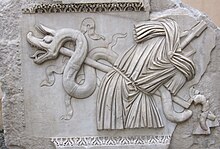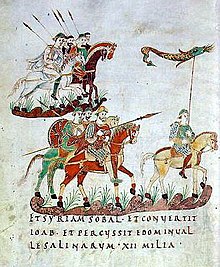Draco standard


The Draco standard ( latin draco "Dragon", altfränkisch location "site") was an antique and medieval military ensigns ( standard ) in the form of a snake with a modeled dragon's head , which was originally the Central Asian horsemen back.
origin
The dragon also played a role in the mythology of Asian steppe peoples, especially the Sarmatians , in which it (also as a winged serpent) held a prominent position. The heavy Sarmatian armored lancers were often compared to dragons by ancient authors in their writings. The standard was also widespread among the Indians , Persians , Parthians , Scythians and Dacians . In the early Middle Ages , the standard was also used by the Frankish armored riders .
function
It is believed that they were originally used for the numerous mounted archers of the equestrian peoples in the Asian steppes to determine wind strength and wind direction. Otherwise, standards were a visual aid for marking troop formations and lone fighters during military operations (especially for orientation on the battlefield).
use
In late antiquity , the Roman army took over together with Asian mercenaries or auxiliary troops and the like. a. the concept for the use of cataphracts , the Spangenhelm , the Contus lance and also the Draco standard, probably from the Dacians or Scythians. The cavalryman who carried the Draco standard was called Draconarius . In the 4th century AD, it was also introduced to the Roman infantry . The form of the Draco standard used by the Romans consists of a long tubular windsock made of red or multi-colored cloth, which is attached to a metal dragon head with an open mouth. A very well preserved dragon head was found in the Niederbieber fort . It consists of silver-plated and partly also gold-plated copper sheet. It could be attached to a simple wooden stick, but was usually attached to a lance. Ammianus Marcellinus also describes a scene in which Constantius II is surrounded by dragon standards interwoven with purple threads, which are stuck on gilded lance tips decorated with precious stones (but probably only stones made of glass). If the dragon mouths were held directly in the wind, they are said to have made a hissing noise. This could have been created by metal fins or wires attached to the inside and should intimidate the enemy.
In addition to the Romans and Byzantines , the Draco standards also used:
In Britain , after the withdrawal of the Roman army, the Draco standard and the dragon's head symbol were continued to be used by the Celts and Anglo-Saxons . This can perhaps be explained by the presence of Sarmatian mercenaries used as cataphracts on Hadrian's Wall (see Sarmatians and Arthurian legend ). Some historians suspect that the dragons in the coats of arms of Wessex , Wales and also in those of other British ruling houses were derived from such draco standards.
literature
- Otto Fiebiger : Draco 2 . In: Paulys Realencyclopadie der classischen Antiquity Science (RE). Volume V, 2, Stuttgart 1905, Col. 1633 f.
Web links
- Robert Vermaat: The Draco, the Late Roman military standard (UK 1999, Dracostandarte with many illustrations)
- The Welsh Dragon . Flag Institute, archived from the original onDecember 12, 2007; accessed on March 9, 2018(English).
Individual evidence
- ↑ Lutz Röhrich : Dragon, Dragon Fight, Dragon Slayer. In: Encyclopedia of Fairy Tales . Concise dictionary for historical and comparative narrative research. Volume: 3: Chronicle Literature - Angels and Erimit. Walter de Gruyter, Berlin et al. 1981, ISBN 3-11-008201-2 , p. 810.
- ↑ Markus Jöckel: Where does the word dragon come from? In: Bernd Schmelz, Rüdiger Vossen (ed.): On dragon tracks. A book on the kite project of the Hamburg Museum of Ethnology. Holos, Bonn 1995, ISBN 3-86097-453-X , pp. 25–31, here pp. 27 f.
